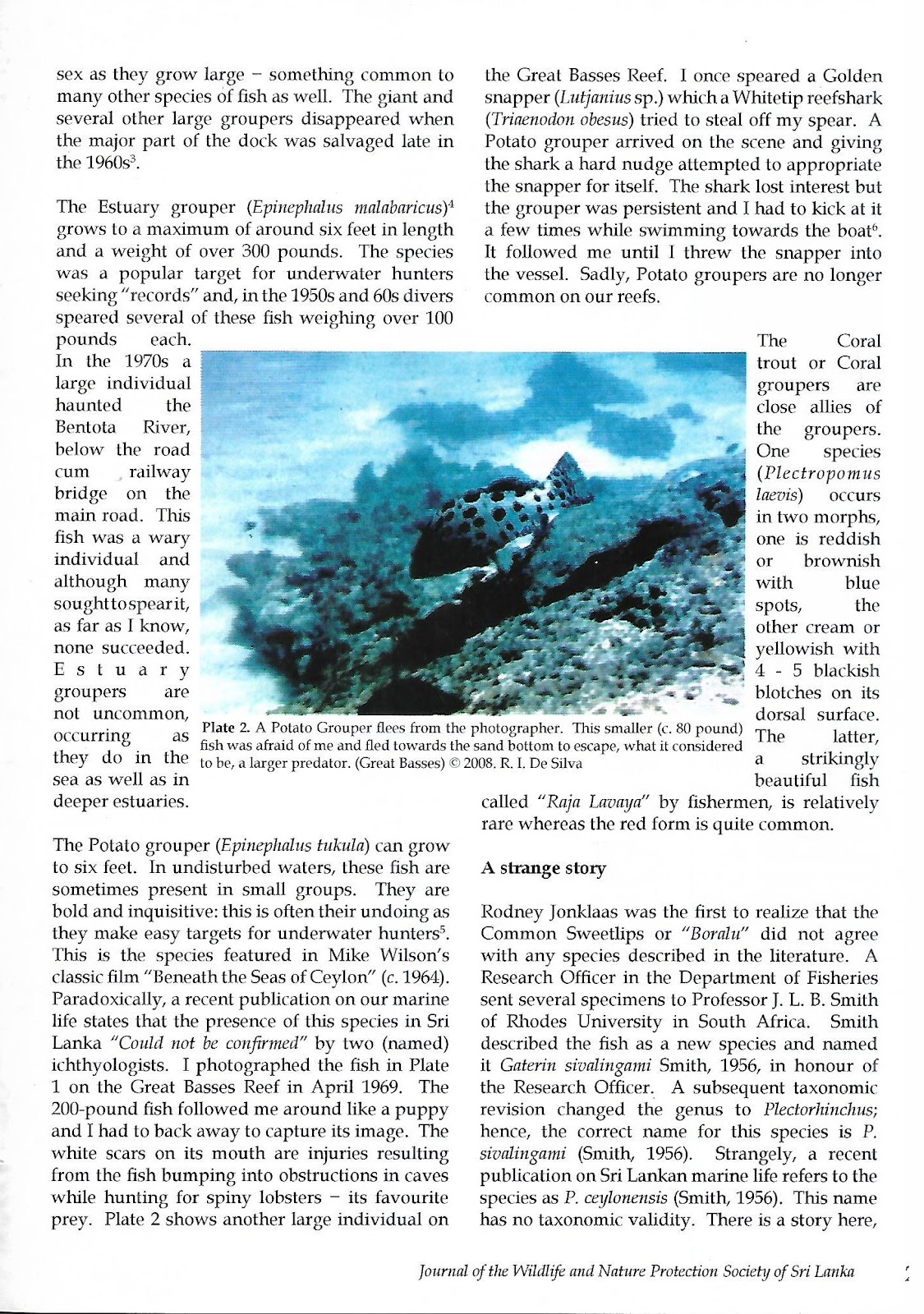Rex I. De
Silva’s Diving History
Rex Ian De Silva FLS MIBiol is compiler of this site. He is a pioneer Sri Lankan diver who has been diving and spearfishing since 1955. He was Secretary and Spearfishing Captain of the Reefcombers of Ceylon, one of the World’s earliest diving clubs. He became a commercial diver in 1968 and continued to dive professionally for over eighteen years. Although no longer diving professionally, he continues to dive for sport and research purposes. He is author of the definitive work '‘The Sharks of Sri Lanka' and approximately 120 scientific research papers, book chapters and other publications.. In 2013 Rex was declared an ‘International Legend of Diving’. Rex is an authority on Sri Lanka’s diving history as he was, and is, an integral part of it . His achievements are detailed below.
· Started spearfishing around 1956 and SCUBA
diving c. 1958.
Some activities as a commercial diver (from
1968 to 1985).
Posts held:
·
Chief Diver for ‘Mobile Marine Engineering
Company’ (Colombo) 1968-1974.
·
Head of ‘Premier Engineers (Colombo) commercial
diving unit’ 1974-1985.
Summary:
·
Qualified for Colombo Port Commission Commercial
Divers’ Licence in 1968.
·
Underwater hull cleaning of Supertanker M/t.
“San Juan Vanguard” (165,000 tons) – the largest vessel to dock in Colombo
Harbour at the time (1972).
·
Underwater hull cleaning of 44 cargo vessels in
Colombo and Trincomalee harbours.
·
Stern tube sealing of several vessels in the
Port of Colombo
· In situ repair of the damaged underwater section of the hull of
M/v “Pulawy” (20,000 tons) in 1974 preventing it from sinking in Colombo
Harbour.
·
Salvaged cargo of mining equipment from the
“Wombat” sunk in deep water off Nilveli Point.
·
Refloated trawler “Maple Leaf” sunk in Colombo
Harbour.
·
Recovered main anchor of M/v. “Drachenfels”
(30,000 tons) lost in silt in Colombo harbour.
·
Underwater sealing of the damaged scour gate and outlet
at Hasalaka tank (reservoir) to prevent it from losing its water content during the cultivation season.
·
Underwater sealing of main outlet of Maduru Oya
reservoir.
·
Underwater salvage operations at Maduru Oya
reservoir
· Annual underwater maintenance and clearing of the main
intakes at Kelanitissa power plant (1970s).
·
Underwater salvage operations in Castlereagh
Reservoir.
·
Underwater search for and recovery of drowned corpses.
·
Training of individuals for commercial diving
operations.
·
Miscellaneous diving, search, rescue, and
salvage operations.
·
Diving operations carried out in the Maldives on
Japanese HOKO company fishery factory vessels.
L
Equipment
used:
·
SCUBA single and twin sets
·
Surface air supply equipment (Hookah) and Air
Buoy.
·
First to operate ‘Brush Buoy’ hydraulic
underwater hull-cleaning machines in Sri Lankan harbours.
·
Oxy-arc underwater cutting equipment used in
salvage work.
Sport Diving
·
Honorary Secretary and Spearfishing Captain of
the “Reefcombers of Ceylon” diving club from the mid-1960s.
·
Began underwater photography in November 1967.
·
Spearfishing Captain of Kinross Swimming &
Life Saving Club 1974.
·
Largest fish speared 115lb Ray.
Scientific activities
·
Studying sharks and marine life since c. 1968. Documented 22 shark species which had
previously not been recorded from Sri Lanka. Documented a further three species of sharks and a single Chimera (Ghost shark) with colleagues.
·
Author of 120 peer-reviewed scientific papers,
book chapters, articles and other publications on Sri Lankan marine life.
·
Declared an "International Legend of
Diving" by the Legends of Diving Organization (USA) in 2013.
·
Author of THE SHARKS OF SRI LANKA. 2015.
·
Currently writing a “History of Diving in Sri
Lanka”
Comments
·
“I have known Rex I De Silva for over two decades and
admire his work and accomplishments in underwater exploration, wildlife and
astronomy”. Sir
Arthur C. Clarke, Chancellor University of Moratuwa. 29 September 2001.
·
“Mr. Rex De Silva, ‘Renaissance Man’, Naturalist,
Environmentalist, Deep Sea Diver, Birder, Martial Arts expert and Scholar is as
unusual as they come”. Vidya Jyoti Ashley de Vos, President of the Wildlife and Nature Protection Society of Sri Lanka (1999-2000). 8th October 2001
· “[Rex De Silva] is a person with an excellent
knowledge of the ocean, land and sky”. Professor Sarath Kotagama, University
of Colombo.
Other:
·
In early 1970s held the Reefcombers SCUBA depth record at 240 feet in the Trincomalee Submarine Canyon. This was also the unofficial Sri Lankan SCUBA depth record.
L Logged an estimated 8,000 - 10,000 dives between 1956 and 2010
· Read “Dharshana Jayawardena interviews
Rex I De Silva” at: https://reximages.blogspot.com/2017/04/dharshanajayawardena-author-of-ghosts.html
· Listed in ‘Who’s who of Sri Lanka’ (volume II).
Other Interests and activities:
·
Former astronomical (lunar occultations) observer
for the United States Naval Observatory (USNO) Station reference SXT94.
·
Current observer/photographer of solar activity.
·
Holder of advanced Black-belt degree in Shotokan
Karate and holder of Master Instructor’s certification (SHIHAN) in martial arts.
Awards
Abacus Institute: Honorary Diploma for
“Outstanding contributions in the field of Environmental Protection", Marine Conservation Forum Award and Mid-city Rotary Vocational Services Award etc.

Text corrected and updated on 10th February 2023
© Rex I. De Silva





















